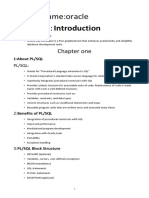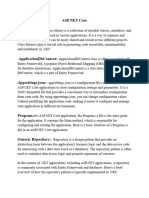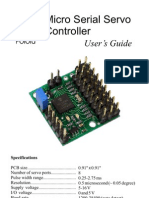Embedded SQL nd ADVANCED SQL
Uploaded by
Reena V 12 AEmbedded SQL nd ADVANCED SQL
Uploaded by
Reena V 12 AEmbedded SQL
Definition: Embedded SQL is a method of combining SQL with a general-purpose programming
language such as C, C++, Java, or COBOL. This allows the execution of SQL queries directly within the
code of the host programming language.
Key Concepts:
1. Host Variables:
o Host variables are used to pass values between the SQL statements and the host
program.
o They are declared in the host language but used in the embedded SQL statements.
2. EXEC SQL Statement:
o SQL statements are embedded in the host language code using the EXEC SQL and
END-EXEC keywords.
3. Error Handling:
o SQLCA (SQL Communication Area) or SQLCODE are used for error handling to
capture the execution status of SQL statements.
Example:
EXEC SQL BEGIN DECLARE SECTION;
int emp_id;
char emp_name[100];
EXEC SQL END DECLARE SECTION;
EXEC SQL SELECT name INTO :emp_name FROM employees WHERE id = :emp_id;
Advantages:
• Seamless Integration: Integrates SQL seamlessly with a programming language.
• Efficiency: Reduces the overhead of context switching between application and database.
• Type Safety: Ensures that data types are consistent between the application and database.
Disadvantages:
• Complexity: Increases the complexity of the application code.
• Portability: May not be portable across different database systems.
Advanced SQL
Definition: Advanced SQL refers to the use of sophisticated SQL techniques and constructs to
perform complex database operations. It includes features like subqueries, joins, indexes, stored
procedures, triggers, views, and complex data types.
Key Concepts:
1. Subqueries:
o Queries within queries to perform more complex operations.
o Example:
SELECT emp_name FROM employees WHERE emp_id IN (SELECT manager_id FROM departments);
2. Joins:
o Combining rows from two or more tables based on related columns.
o Types include INNER JOIN, LEFT JOIN, RIGHT JOIN, and FULL OUTER JOIN.
o Example:
SELECT e.emp_name, d.dept_name FROM employees e
INNER JOIN departments d ON e.dept_id = d.dept_id;
3. Indexes:
o Special database objects that improve the speed of data retrieval.
o Example:
CREATE INDEX idx_emp_name ON employees(emp_name);
4. Stored Procedures:
o Precompiled collections of SQL statements stored in the database.
o Example:
CREATE PROCEDURE GetEmployeeDetails (IN emp_id INT)
BEGIN
SELECT emp_name, emp_salary FROM employees WHERE emp_id = emp_id;
END;
5. Triggers:
o Automated actions performed in response to certain events on a table.
o Example:
CREATE TRIGGER after_insert_employee
AFTER INSERT ON employees
FOR EACH ROW
BEGIN
INSERT INTO audit_log (event, emp_id, timestamp)
VALUES ('INSERT', NEW.emp_id, NOW());
END;
6. Views:
o Virtual tables created by a query to simplify complex queries.
o Example:
CREATE VIEW employee_details AS
SELECT emp_name, dept_name FROM employees e
JOIN departments d ON e.dept_id = d.dept_id;
Advantages:
• Efficiency: Enhances performance through optimization techniques like indexing and
precompiled stored procedures.
• Reusability: Promotes code reuse with stored procedures and views.
• Maintainability: Simplifies maintenance by encapsulating complex logic within the database.
Disadvantages:
• Complexity: Advanced features can make the SQL code more complex and harder to debug.
• Resource Intensive: Some advanced features, like triggers, can consume more database
resources.
You might also like
- CCS370 UI and UX Design Lecture Notes 1No ratings yetCCS370 UI and UX Design Lecture Notes 1102 pages
- DBMS - Module 3 Ppts - Jan28th (Autosaved)No ratings yetDBMS - Module 3 Ppts - Jan28th (Autosaved)104 pages
- 9.Stored Procedures & Case Study - Internet BookshopNo ratings yet9.Stored Procedures & Case Study - Internet Bookshop40 pages
- SQL Server Interview Questions: Explain The Use of Keyword WITH ENCRYPTION. Create A Store Procedure With EncryptionNo ratings yetSQL Server Interview Questions: Explain The Use of Keyword WITH ENCRYPTION. Create A Store Procedure With Encryption11 pages
- Subject Name:oracle Part: PLSQL:: Chapter OneNo ratings yetSubject Name:oracle Part: PLSQL:: Chapter One12 pages
- SQL Server Interview Questions: Explain The Use of Keyword WITH ENCRYPTION. Create A Store Procedure With EncryptionNo ratings yetSQL Server Interview Questions: Explain The Use of Keyword WITH ENCRYPTION. Create A Store Procedure With Encryption10 pages
- K. J. Somaiya College of Engineering, Mumbai-77No ratings yetK. J. Somaiya College of Engineering, Mumbai-7714 pages
- DBMS GTU Study Material Presentations Unit-10 17102019083650AMNo ratings yetDBMS GTU Study Material Presentations Unit-10 17102019083650AM39 pages
- Practical File of Advanced Database Management System Lab: CSP2301 Bachelor of EngineeringNo ratings yetPractical File of Advanced Database Management System Lab: CSP2301 Bachelor of Engineering29 pages
- Write A Query To Assign Create, Select, Update Privilege On Empno Column of Emp Table To Rahul UserNo ratings yetWrite A Query To Assign Create, Select, Update Privilege On Empno Column of Emp Table To Rahul User7 pages
- 08 09 (5) SQL Database Programming LandscapeNo ratings yet08 09 (5) SQL Database Programming Landscape23 pages
- DBMS - Unit 3 - Notes (Embedded & Dynamic SQL)No ratings yetDBMS - Unit 3 - Notes (Embedded & Dynamic SQL)23 pages
- CCS370 UI and UX Design Lecture Notes 2No ratings yetCCS370 UI and UX Design Lecture Notes 2237 pages
- Explain the mongo DB working with node.jsNo ratings yetExplain the mongo DB working with node.js4 pages
- List of 7400 Series Integrated Circuits-2003No ratings yetList of 7400 Series Integrated Circuits-20037 pages
- RecoverPoint 5.1 Customer Installation and Upgrade GuideNo ratings yetRecoverPoint 5.1 Customer Installation and Upgrade Guide42 pages
- Welcome To: Oracle Spatial Workshop For ManagementNo ratings yetWelcome To: Oracle Spatial Workshop For Management19 pages
- Pololu Micro Serial Controller Ssc03a - GuideNo ratings yetPololu Micro Serial Controller Ssc03a - Guide8 pages
- Database Systems: Database Systems: Design, Implementation, and Management, Seventh Edition, Rob and CoronelNo ratings yetDatabase Systems: Database Systems: Design, Implementation, and Management, Seventh Edition, Rob and Coronel50 pages
- Stalker Stationary Speed Sensor II Technical ManualNo ratings yetStalker Stationary Speed Sensor II Technical Manual71 pages
- Module 4 - 5G Protocol Architecture: Nex-G Innovations - NESPLNo ratings yetModule 4 - 5G Protocol Architecture: Nex-G Innovations - NESPL30 pages
- Pages From Cisco-VCS-IP-Port-Usage-for-Firewall-Traversal-Deployment-GuideNo ratings yetPages From Cisco-VCS-IP-Port-Usage-for-Firewall-Traversal-Deployment-Guide1 page
- 3042 - New ABARS Related Products For Improved Disaster Recovery EffectivenessNo ratings yet3042 - New ABARS Related Products For Improved Disaster Recovery Effectiveness32 pages
- 5 Designing Dropbox - Grokking The System Design InterviewNo ratings yet5 Designing Dropbox - Grokking The System Design Interview10 pages































































































